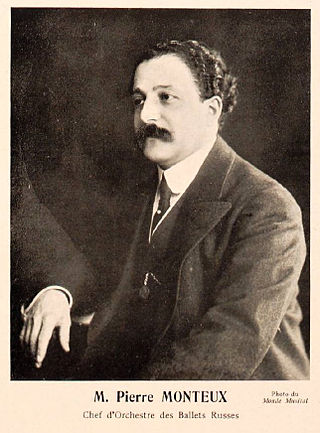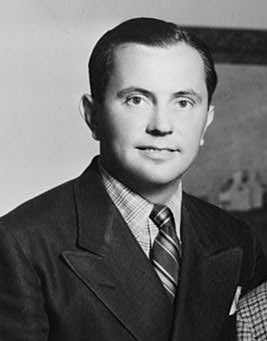
Pierre Benjamin Monteux was a French conductor. After violin and viola studies, and a decade as an orchestral player and occasional conductor, he began to receive regular conducting engagements in 1907. He came to prominence when, for Sergei Diaghilev's Ballets Russes company between 1911 and 1914, he conducted the world premieres of Stravinsky's The Rite of Spring and other prominent works including Petrushka, The Nightingale, Ravel's Daphnis et Chloé, and Debussy's Jeux. Thereafter he directed orchestras around the world for more than half a century.

Sir Henry Joseph Wood was an English conductor best known for his association with London's annual series of promenade concerts, known as the Proms. He conducted them for nearly half a century, introducing hundreds of new works to British audiences. After his death, the concerts were officially renamed in his honour as the "Henry Wood Promenade Concerts", although they continued to be generally referred to as "the Proms".

Serge Koussevitzky was a Russian and American conductor, composer, and double-bassist, known for his long tenure as music director of the Boston Symphony Orchestra from 1924 to 1949.

The Turangalîla-Symphonie is the only symphony by Olivier Messiaen (1908–1992). It was written for an orchestra of large forces from 1946 to 1948 on a commission by Serge Koussevitzky for the Boston Symphony Orchestra. Along with the Quatuor pour la fin du temps, the symphony is one of the composer's most notable works.

The Queen's Hall was a concert hall in Langham Place, London, opened in 1893. Designed by the architect Thomas Knightley, it had room for an audience of about 2,500 people. It became London's principal concert venue. From 1895 until 1941, it was the home of the promenade concerts founded by Robert Newman together with Henry Wood. The hall had drab decor and cramped seating but superb acoustics. It became known as the "musical centre of the [British] Empire", and several of the leading musicians and composers of the late 19th and early 20th centuries performed there, including Claude Debussy, Edward Elgar, Maurice Ravel and Richard Strauss.

Vernon Duke was a Russian-born American composer and songwriter who also wrote under his birth name, Vladimir Dukelsky. He is best known for "Taking a Chance on Love," with lyrics by Ted Fetter and John Latouche (1940), "I Can't Get Started," with lyrics by Ira Gershwin (1936), "April in Paris," with lyrics by E. Y. ("Yip") Harburg (1932), and "What Is There To Say," for the Ziegfeld Follies of 1934, also with Harburg. He wrote the words and music for "Autumn in New York" (1934) for the revue Thumbs Up! In his book, American Popular Song, The Great Innovators 1900-1950, composer Alec Wilder praises this song, writing, “The verse may be the most ambitious I’ve ever seen." Duke also collaborated with lyricists Johnny Mercer, Ogden Nash, and Sammy Cahn.
Sergei Prokofiev began his Violin Concerto No. 1 in D major, Op. 19, as a concertino in 1915 but soon abandoned it to work on his opera The Gambler. He returned to the concerto in the summer of 1917. It was premiered on October 18, 1923 at the Paris Opera with Marcel Darrieux playing the violin part and the Paris Opera Orchestra conducted by Serge Koussevitzky. Igor Stravinsky made his debut as conductor at the same concert, conducting the first performance of his own Octet for Wind Instruments.

Harold en Italie, symphonie avec un alto principal, as the manuscript describes it, is a four-movement orchestral work by Hector Berlioz, his Opus 16, H. 68, written in 1834. Throughout, the unusual viola part represents the titular protagonist, without casting the form as a concerto. The movements have these titles, alluding to a programme:
- Harold in the mountains
- March of the pilgrims
- Serenade of an Abruzzo mountaineer
- Orgy of bandits

Jacob Raphael Druckman was an American composer born in Philadelphia.

La mer, trois esquisses symphoniques pour orchestre, or simply La mer, L. 109, CD. 111, is an orchestral composition by the French composer Claude Debussy.

Nocturnes, L 98 is an Impressionist orchestral composition in three movements by the French composer Claude Debussy, who wrote it between 1892 and 1899. It is based on poems from Poèmes anciens et romanesques.

The Tanglewood Music Center is an annual summer music academy in Lenox, Massachusetts, United States, in which emerging professional musicians participate in performances, master classes and workshops. The center operates as a part of the Tanglewood Music Festival, an outdoor concert series and the summer home of the Boston Symphony Orchestra (BSO).

A Survivor from Warsaw, Op. 46, is a work for narrator, chorus and orchestra by the Los Angeles–based Austrian composer Arnold Schoenberg, written in tribute to Holocaust victims. The main narration is written in Sprechgesang style, between speaking and singing; "never should there be a pitch" to its solo vocal line, wrote the composer.
The Symphonies of Wind Instruments is a concert work written by Igor Stravinsky in 1920, for an ensemble of woodwind and brass instruments. The piece is in one movement, lasting about 9 minutes. It is dedicated to the memory of Claude Debussy, who died in 1918, and was premiered in London on 10 June 1921, conducted by Serge Koussevitzky.
Ode: Elegiacal Chant in Three Parts is an orchestral work from 1943 composed by Igor Stravinsky. Prior to its completion, the score's working title had been Triads.
The Symphony No. 3 by Walter Piston was composed in 1946–47.
The Symphony No. 2, Op. 247, is a work for orchestra by French composer Darius Milhaud. It was written in the U.S. in 1944 on a commission from the Koussevitzky Music Foundations in memory of Serge Koussevitzky's second wife Natalie, who had died in 1942. The premiere of the work was played by the Boston Symphony Orchestra in 1946, with the composer himself conducting.
Secular Cantata No. 2: A Free Song is a cantata for chorus and orchestra by William Schuman, using text by Walt Whitman, that was awarded the first Pulitzer Prize for Music in 1943, after it was premiered by the Boston Symphony Orchestra under Serge Koussevitzky. Music Sales Classical describes it as containing, "granite-like blocks of dissonant harmony and sharp-edged counterpoint."
The Concerto for Piano and Orchestra is a musical composition by the American composer Aaron Copland. The work was commissioned by the conductor Serge Koussevitzky who was then music director of the Boston Symphony Orchestra. It was first performed on January 28, 1927, by the Boston Symphony Orchestra conducted by Koussevitzky with the composer himself as the soloist. The piece is dedicated to Copland's patron Alma Morgenthau Wertheim.
The Short Symphony, or Symphony No. 2, is a symphony written by the American composer Aaron Copland from 1931 to 1933. The name derives from the symphony's short length of only 15 minutes. The work is dedicated to Copland's friend, the Mexican composer and conductor Carlos Chávez. The symphony's first movement is in sonata-allegro form, and its slow second movement follows an adapted ternary form. The third movement resembles the sonata-allegro but has indications of cyclic form. The composition contains complex rhythms and polyharmonies, and it incorporates the composer's emerging interest in serialism as well as influences from Mexican music and German cinema. The symphony includes scoring for a heckelphone and a piano while omitting trombones and a percussion section. Copland later arranged the symphony as a sextet.












